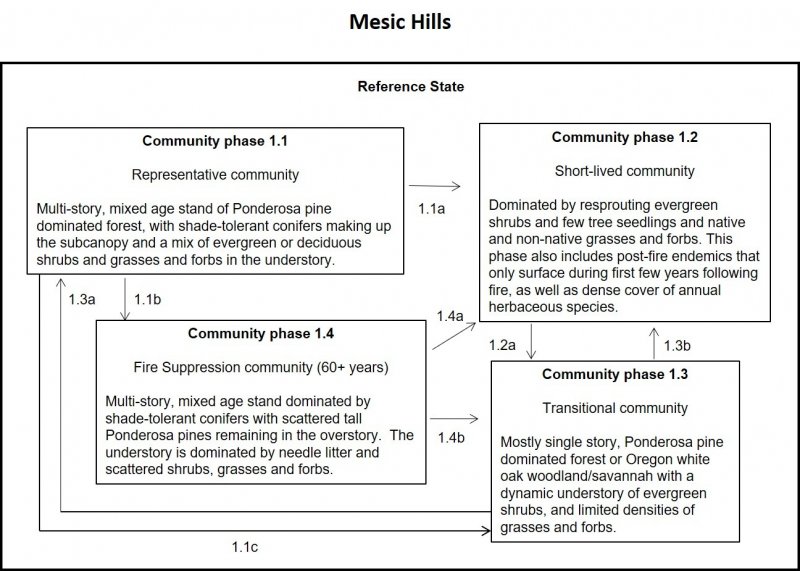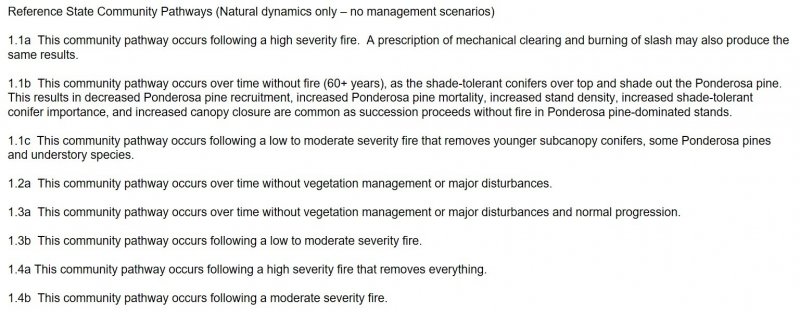Ecological site group F005XZ006CA
Mesic Hills <40"ppt
Last updated: 06/11/2025
Accessed: 10/19/2025
Ecological site group description
Key Characteristics
None specified
Provisional. A provisional ecological site description has undergone quality control and quality assurance review. It contains a working state and transition model and enough information to identify the ecological site.
Physiography
This ESG is found on mesic hills on slopes that are variable but typically range from 10 to 50% slopes at a wide range of elevations.
Climate
The average annual precipitation in this MLRA is typically 32 to 89 inches (407 to 4,228 millimeters), with small areas that can be as low as 16 inches and other high elevation areas that can reach up to 166 inches on average. Most of the rainfall occurs as low-intensity, Pacific frontal storms. Rain turns to snow at the higher elevations. Very little precipitation occurs in summer when temperatures can be quite high. Most of the precipitation occurs between November and April. The average annual temperature is 39 to 62 degrees F (4 to 17 degrees C), decreasing with elevation. The freeze-free period averages 240 days and ranges from 110 to 365 days. The shorter freeze-free periods occur at the higher elevations.
Soil features
The soils that primarily dominate this ESG are a mix of very deep, somewhat excessively drained soils formed in material weathered from sandstone and very deep, moderately well drained soils that formed in material weathered from chloritic schist and other sedimentary and metamorphic rocks.
Holland, a fine-loamy, mixed, active, mesic Ultic Haploxeralfs
Medco, a fine, smectitic, mesic Ultic Haploxerolls
Vegetation dynamics
This ESG covers the mesic hills less than 40 inches average precipitation within MLRA 5 that were at one time part of a vast complex of ponderosa pine and Oregon white oak woodlands and savannahs. Native American burning, suppression of fires, and the fragmented and urbanized landscape on these more accessible areas within this MLRA makes it difficult to imagine the natural landscape prior to human development and influences.
Tree spacing in ponderosa pine stands varies from open patchy to moderately closed. Other conifers, when present, provide denser crowns than do the pine, thus creating habitat diversity. Grasses, shrubs, and deciduous trees may be present or absent. Typical coverage of shrubs is 10-30% and of grasses and forbs is 5-10%. The ponderosa pine habitat includes pure stands of ponderosa pine as well as stands of mixed species in which at least 50% of the canopy area is ponderosa pine. Associated species vary depending on location in the state and site conditions. Typical tree associates include Jeffrey pine, sugar pine, Douglas-fir, canyon live oak, California black oak, Oregon white oak, Pacific madrone and tanoak.
Associated shrubs include manzanita, ceanothus, mountain-misery, Pacific dogwood, hairy yerba-santa, yellowleaf silktassel, bitter cherry, California buckthorn, poison-oak, Sierra gooseberry. Grasses and forbs include slimleaf brome, Orcutt brome, carex, smallflower melicgrass, bluegrass, bottlebrush squirreltail, bedstraw, bracken fern, bush morning-glory, rhomboid clarkia, Child's blue-eyed mary, shrubby eriastrum, splendid gilia, Sierra iris, whisker-brush, Inyo bush lupine, summer lupine, purple nightshade, streptanthus, gooseroot violet, and wild iris.
Most ponderosa pine stands that include other coniferous trees probably are maintained by periodic ground fires. In many of these stands, crown fires result in dense montane chaparral communities. Young, dense stands, as in plantations, exclude most undergrowth once trees attain a closed canopy. Prior to that, dense brush is typical, but an herbaceous layer may develop on some sites. On sites or areas that are dry or of low quality, significant pine regeneration may depend on concurrent disturbance of chaparral and a good pine seed crop with favorable weather. Thus, it may require 50-100 years for significant pine regeneration in the absence of intervention. Clearcuts with minimal brush control develop a dense stand of pole-size trees in 2030 years, twice the time required when brush is completely removed. Dense brush is typical in young stands and an herbaceous layer may develop on some sites.
On drier sites, there is less tendency for succession toward shade-adapted species. Sites disturbed by fire or logging sometimes are converted to dense montane chaparral or mixed chaparral. Moist chaparral areas of higher site quality tend to develop directly into mixed conifer stands. As young, dense stands age and attain a closed canopy, they exclude most undergrowth. If allowed to continue, such succession may change the structure and composition of the stand within 40 years sufficiently to favor wildlife adapted to mixed conifer habitats. Most ponderosa pine stands that include other coniferous trees probably are maintained by periodic ground fires.
Information from:
California Wildlife Habitat Relationships System
California Department of Fish and Game
California Interagency Wildlife Task Group
E. Lee Fitzhugh
Major Land Resource Area
MLRA 005X
Siskiyou-Trinity Area
Stage
Provisional
Click on box and path labels to scroll to the respective text.

